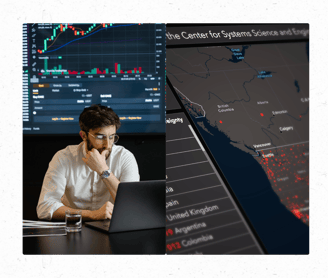Top trends in Data Visualization
BLOG


In today's fast-paced world, data visualization has become an important tool for conveying complex information. The art of visual storytelling has emerged as a potent technique for communicating insights and captivating audiences.
From interactive dashboards to dynamic animations, a multitude of data visualization trends are reshaping the landscape of storytelling with data. In this article, we will focus on top 5 trends in visual storytelling and their potential to transform how we convey information across various industry roles.
Whether you're a data analyst, a journalist, or simply an enthusiast intrigued by data-driven narratives, this article offers valuable insights into the dynamic realm of data visualization.
Understanding Data Visualization
In recent years, the practice of data visualization has gained momentum as organizations increasingly recognize the significance of data-informed decision-making.
As the era of big data unfolds and business intricacies grow, an effective means of deciphering and interpreting data has become indispensable. Data visualization stands as a formidable tool for accomplishing this feat, enabling users to create visual displays of intricate datasets in a manner that is both accessible and intelligible.
With diverse forms of data visualization available, each with its own strengths and limitations, these visualizations serve to emphasize distinct facets of data. These may encompass trends over time, comparisons between variables, or spatial correlations.
The Benefits of Data Visualization
Among the many merits of data visualization, the ability to swiftly identify patterns and trends within complex datasets stands out prominently. By spotting these trends, users can gain insights that might otherwise have gone unnoticed, fostering more enlightened decision-making based on data-driven revelations. Additionally, data visualization excels at conveying intricate data in an understandable and digestible manner. This aspect holds particular importance when presenting data to non-experts or stakeholders without extensive data analysis backgrounds. Utilizing intuitive and comprehensible visualizations ensures that messages are effectively conveyed, and recommendations are heeded. Additionally, data visualization plays a vital role in error detection by making anomalies and irregularities within datasets visually apparent, aiding data analysts and researchers in promptly addressing data quality issues and ensuring the reliability of the information presented.
Exploring the Top 5 Data Visualization Trends
1. Real-Time Data Visualization
Real-time data visualization is a growing trend across industries that helps companies quickly spot challenges and opportunities. It enables timely and well-informed decisions by swiftly identifying issues in business strategies, customer retention, and brand visibility. Recent surveys show that many consider real-time data essential, believing it directly impacts revenue growth. Companies adopting this approach gain a competitive edge by effectively managing risks, spotting emerging opportunities, and making prompt strategic choices. They can combine real-time data with historical data in dashboards for more powerful analysis. In sectors like logistics and shipping, where real-time data integration is crucial, it helps determine shipment locations, delivery timelines, and potential hurdles. Real-time data visualization goes beyond businesses, transforming decision-making in fields such as education and transportation.
2. Video Visualization
Video visualization, a burgeoning trend in 2023, is hinged on the preference of users to learn about new products or services through video content. Videos exhibit a capacity to captivate audiences, and their impact extends beyond entertainment to education and retention.
Surpassing text and images, videos enable superior data retention, making video infographics and commercials powerful tools for customer engagement and business strategy.
3. Data Democratization
The notion of data democratization, surging in relevance involves providing universal data access. Enabling employees across organizations to access, analyze, and visualize data independently empowers data-informed decisions and facilitates communication to leadership through visualizations.No-code/low-code solutions, instrumental in this process, enable users with minimal coding experience to craft tailored data experiences.
This approach helps transparency and inclusion.
4. AI and Machine Learning Data Visualization
The integration of AI and machine learning marks a pivotal trend in data visualization. These technologies play a pivotal role in producing accurate and effective data visualizations, overcoming human limitations in categorizing raw data. AI ensures unbiased, accurate data categorization, reducing biases and errors inherent in human analysis. AI augments businesses by identifying intricate trends invisible to human observers, thereby enhancing data visualization's efficacy. Predictive models developed with AI assist in anticipating future trends, driving agile adaptation.
As technology evolves, AI and machine learning will remain pivotal in data visualization, equipping businesses for informed decisions and improved outcomes.
5. Mobile Compatible Visualizations
The evolving landscape of internet access, with mobile devices accounting for a substantial share, underscores the prominence of mobile-compatible data visualizations. Accessible across social media, websites, and online platforms, mobile-compatible visualizations are imperative for customer engagement and retention.
Embracing mobile data visualization offers a competitive edge, enabling seamless interaction with digital content. Failing to ensure responsiveness on mobile devices can lead to customer churn and missed opportunities.
Conclusion
In essence, data visualization has evolved into an essential way for businesses to communicate insights effectively. In the face of burgeoning digital media and exponential data growth, harnessing contemporary data visualization trends is pivotal for maintaining a competitive edge. Embracing these trends empowers businesses to craft compelling visual narratives that resonate with audiences, fostering engagement.
Whether you're a marketer, data analyst, or business owner, integrating these trends into your data visualization strategy enables you to convey intricate data lucidly, concisely, and visually. Remaining attuned to evolving trends empowers businesses to forge impactful visual stories that leave indelible impressions, bolster brand image, and drive success in today's data-driven landscape.
